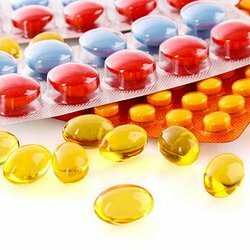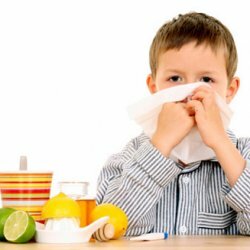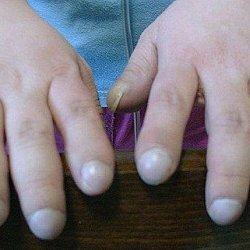Vesiculopustulosis
 Vesiculopustulosis is a pathology of the skin in newborn infectious genesis, which has an acute course, manifested by an inflammatory reaction in the eccrine sweat glands. Currently, vesiculopustulosis occurs infrequently. This is due to the active anti-epidemic measures in the institutions of delivery, the practice of joint stay in the postpartum department of mothers and newborns, active monitoring of pregnant women and timely detection, treatment, prevention of staphylococcal infections.
Vesiculopustulosis is a pathology of the skin in newborn infectious genesis, which has an acute course, manifested by an inflammatory reaction in the eccrine sweat glands. Currently, vesiculopustulosis occurs infrequently. This is due to the active anti-epidemic measures in the institutions of delivery, the practice of joint stay in the postpartum department of mothers and newborns, active monitoring of pregnant women and timely detection, treatment, prevention of staphylococcal infections.
The danger of vesiculopustuleis is that in the neonatal period the skin of the newborn has some peculiarities, which makes it difficult to conduct differential diagnosis with infectious diseases of the skin of another etiology, rashes of non-infectious genesis. This increases the possibility of untimely diagnosis and complications.
Causes of vesiculopustule in newborns
Vesiculopustulosis in children develops during the neonatal period. It belongs to the group of staphylodermia and is caused, as a rule, by cocci flora. The main pathogens are staphylococci( Staph. Haemolyticus, Staph. Saprophyticus, Staph aureus, Staph. Epidermidis).The following factors predispose to the increased risk of infection of the infectious agent and the development of vesiculopustules:
- infection of staphylococcal etiology in pregnant women in chronic or acute form;
- poor epidemiological situation in the departments where newborns receive help( postpartum, pediatric, neonatal, intensive care, resuscitation);
- unsatisfactory hand hygiene of caregivers or assisting newborns;
- decreased immunity in weakened children( those born before the term, traumatized, having certain congenital or acquired diseases);
- improper skin care for a newborn( overheating or hypothermia, non-compliance with temperature conditions, presence of diaper rash, cracks, microtrauma, etc.);
- features of skin structure of children of the first days after birth( propensity to exudation, maceration);
- artificial feeding.
When the causative agent causing staphylococcal vesiculopustulosis comes to the child's skin, it provokes an inflammatory reaction in the tubular eccrine sweat glands.
Symptoms of vesiculopustule in newborns
Vesiculopustulosis in children is clinically manifested depending on the term of contamination by the pathogen, it can be:
- congenital vesiculopustulosis, infection occurs in utero, in the last months of pregnancy. Clinical manifestations are noted from birth or during the first two days of life;
- Intranatal infection occurs during childbirth, when the child passes the birth canal. Symptoms appear on the third day after birth;
- postnatal contamination by the pathogen occurs after birth. The signs of the disease appear on the fifth day of life.
Staphylococcal vesiculopustulosis occurs in the areas of the location of the eccrine sweat glands, which are absent only in the region of the lips and genitals. The inflammation is manifested by the formation of a vesicle filled with transparent contents, which becomes cloudy with time - a pustule is formed. Around the element there is a corolla of hyperemia. Bubble sizes from 2 to 5 millimeters in diameter. Between each other, the elements of the rash tend to merge. After opening the pustule, an erosion zone is formed, eventually it becomes covered with a dry crust. There are no traces after falling off of crusts.
Vesicles are localized throughout the body, the preferred location of the rash: on the scalp, in the natural folds of the skin. Elements can be single, but can appear in large numbers, merging, form large areas of damage.
If staphylococcal vesiculopustulis occurs in an initially healthy newborn, then there will be no significant systemic manifestations of the disease. The process proceeds without disturbing the child's well-being, against the background of treatment inflammation quickly fades and a complete clinical recovery occurs.
If there was vesiculopustulosis in children weakened, the disease will proceed in a more severe form. With the onset of the infectious process, symptoms of general intoxication appear. The newborn becomes sluggish, capricious, refuses to eat or sluggishly sucks, regurgitation occurs. The skin can become pale, the mucous membranes dry. The temperature of the body rises to the febrile figures.
In clinical clinical blood analysis with a mild form of vesiculopustule, there may not be any changes. In severe and widespread process, inflammatory changes appear in the blood, characteristic for bacterial infection( increase in leukocytes with a stab, a rise in ESR).
The clinic for the flow of vesiculopustularis is typical and the diagnosis of this disease is not difficult. But there are a number of conditions and diseases of the newborn's skin that require differential diagnosis. Similar clinical manifestations have:
- toxic erythema. Transitional state of the skin of the newborn. The element is represented by a dense papule of white or yellowish color in the center of a patch of irregular shape. Rashes do not happen on the scalp. The rash is not a draining character. Treatment is not required;
- fungal dermatitis. Also in the folds of the skin are formed vesicles and pustules with a thin coating, which quickly merge. After the opening of the tire, erosion with bright, scalloped edges is formed;
- scabies complicated by pyoderma. Pustules are located in pairs on the extensor surfaces of the forearms, legs, palms, buttocks, around the navel. Itching is found between the elements of the rash.
In most cases, staphylococcal vesiculopustulosis proceeds smoothly, without complications. But it happens that in children with pathology of neonatal period, without receiving proper treatment and care there are bacterial complications, such as:
- omphalitis( inflammation of the subcutaneous fat and skin around the navel);
- reactive thrombophlebitis of the umbilical vessels against the background of omphalitis;
- pneumonia, conjunctivitis, otitis media, meningitis;
- phlegmon, abscess of the subcutaneous fat layer;
- sepsis.
Treatment vezikulopustuleza neonates
Staphylococcal vezikulopustulez occurs, in most cases, easily, therapy can be done at home, under the supervision of a pediatrician. Indications for inpatient treatment is the presence of common rashes, inflammatory blood reactions.
vezikulopustuleza goal of treatment is skin brushing, used for this purpose:
- hygiene bath broths succession, chamomile, celandine, with potassium permanganate solution at a ratio of 1: 10000.To the bath elements are removed with a cotton ball moistened with 70% ethanol alcohol;
- treatment of the skin with vesiclepustulose is carried out twice a day, for this, the elements are applied with brilliant green, Bactroban, non-aniline dyes;
- UV irradiation, after consultation of a physiotherapist;
- when moderate and severe shown antibiotics( oxacillin, methicillin, Cephalosporins 1st generation integrated with aminoglycosides, vancomycin, amikacin, Linezolid);
- specific immunotherapy( plasma, antistaphylococcal immunoglobulin);
- infusion, symptomatic, vitamin therapy.
Prevention vezikulopustuleza
Given that vezikulopustulez children early neonatal period is the result of transmission from the mother, in violation of hygiene during care, manipulation, requiring contact with the newborn skin, then the actions of prevention should be aimed at preventing the contamination of the skinChild pathogenic microorganisms.
main ways of preventing vezikulopustuleza:
- identification of women of childbearing age, foci of chronic infection( dental caries, tonsillitis, pyelonephritis, sinusitis, otitis media, cystitis, etc.) and their rehabilitation, before pregnancy;
- during pregnancy, also revealing and sanitation of foci of infection, prevention of recurrences of chronic bacterial infection;
- rational prophylaxis during childbirth, if necessary and according to strict indications;
- careful hygiene of the hands of medical personnel who provide assistance to the newborn, the mother in childbirth;
- the first application to the breast, the initiation of breastfeeding in the first 30 minutes after the baby was born, skin-to-skin contact immediately after birth;
- prevention of hyperthermia and hypothermia, strict adherence to the foundations of the "thermal chain";
- joint stay in the postpartum department, exclusively breastfeeding from the first hours of life;
- a daily examination of a pediatrician and the necessary medical and preventive measures are carried out only after the treatment and disinfection of the hands of medical personnel, in accordance with accepted hygienic rules and norms;
- only the mother takes care of the child, contacts with the staff of the department should be minimized, unreasonable movements of the child in the ward and wards are strictly prohibited, all medical and nursing medical and diagnostic measures( ultrasound, x-ray diagnostics, blood collection, urine, feces for analysis, Vaccination, audiological and neonatal screening) are conducted in the ward where the newborn is located;
- in chambers where newborn babies are to be observed the thermal regime must be observed, the chambers must be filled cyclically, ventilation, quartz, cleaning with disinfectants should be carried out regularly;
- the means for caring for the child must be strictly individual, after each swaddling the changing table is wiped with a rag with disinfectant solution;
- health education work with medical personnel assisting mothers and newborns, regular medical examinations and detection of carriers of infectious agents of staphylodermia;
- in the room where the baby is to be kept it should not be hot( the desired temperature is up to 24 ° C), it should often be ventilated and cleaned by a damp method( washing floors, dusting) daily;
- when bathing a newborn, you do not need to use drying agents, unless it is prescribed by the doctor, the baths should be daily, during the first month in the individual bath. Washing with baby soap or bathing means is carried out once a week;
- prevention of diaper rash. The clothing of the child is selected, according to the temperature of the environment, a tight swaddling is contraindicated. The diaper is changed after each act of defecation with soap washing. Disposable diapers are changed every 3 hours, with obligatory air baths. Reusable diapers change as they get wet, make sure you use a cream under the diaper. Inspection and treatment of natural skin folds daily. For abrasions, redness, fissures, the means containing Dexapanthenol are used;
- care for the newborn should be carried out by a narrow circle of persons, if possible only the mother;
- there is no specific prophylaxis of vesiculopustule.
Vesiculopustulosis in children occurs as a result of contamination of the skin of the child with Staphyloderma pathogens, in the presence of predisposing factors. The course of the disease, in most cases, is mild, and, provided that the treatment of the skin with vesiculopustule and the adherence to routine measures are carried out to the fullest, complete recovery occurs. But despite this, children who have suffered this disease are at risk for developing purulent-inflammatory diseases, which requires more careful observation by the pediatrician. At the same time, vesiculopustulosis in children weakened, can cause severe bacterial complications, which aggravates the condition for the underlying disease, and in rare cases can lead to death. Therefore, it is important to comply with all measures to prevent the development of infection in a newborn baby.



